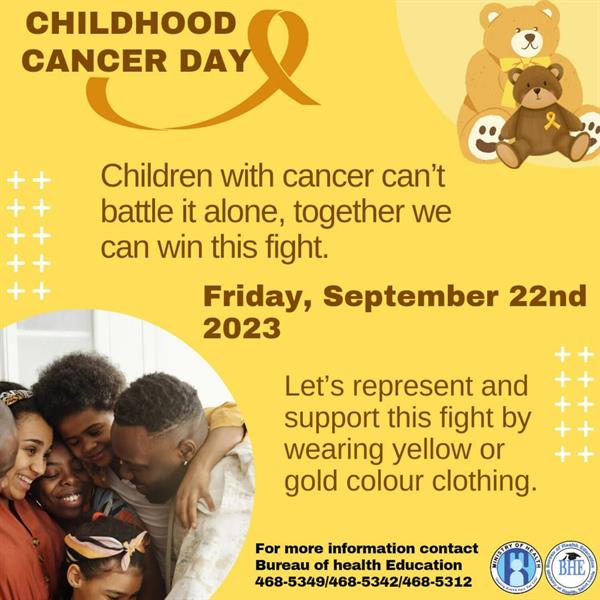THE MINISTRY OF HEALTH OBSERVES CHILDHOOD CANCER AWARENESS ON SEP. 22.
 In a national statement issued in recognition of the Childhood Cancer Awareness Day, the Chief Medical officer within the Ministry of Health Wellness and Elderly Affairs spoke to Childhood Cancer on a national level.
In a national statement issued in recognition of the Childhood Cancer Awareness Day, the Chief Medical officer within the Ministry of Health Wellness and Elderly Affairs spoke to Childhood Cancer on a national level.
“Between 2019 and 2022 we have diagnosed nine cases of childhood cancer in country. The most common types diagnosed being leukaemia and lymphomas. Unlike cancer in adults, the vast majority of childhood cancers do not have a known cause. Current data suggests a genetic predisposition in about 10 percent of the cases. Unfortunately, the likelihood of surviving a diagnosis of childhood cancer depends on the country in which the child lives—in high-income more developed countries, more than 80 percent of children with cancer are cured, but in many low income less developed countries less than 30 percent are cured. The lower survival rates are due to reduced capacity of the healthcare system which leads to delays in diagnosis, inaccessible or expensive therapy, non- compliance to treatment, death from toxicity (side effects), and relapse.”
The CMO continued by emphasizing the symptoms that parents and guardians should look out for and procedures that can be implemented to yield a positive outcome.
“When identified early, cancer is more likely to respond to effective treatment and result in a greater probability of survival, less suffering, and often less expensive and less intensive treatment. It is important that parents and family members recognize the symptoms of childhood cancers. Childhood cancer is associated with a range of warning symptoms, such as fever, severe and persistent headaches, bone pain and weight loss, that can be detected by families and by trained primary health-care providers. One of the most effective strategies to reduce the burden of cancer in children and improve outcomes is to focus on a prompt, correct diagnosis followed by effective, evidence-based therapy with tailored supportive care. This includes accurate and timely clinical evaluations, diagnosis, and staging and access to prompt care. Improving access to childhood cancer care, including to essential medicines and technologies, is highly cost effective, feasible and can improve survival in all settings.”
The public is asked to wear yellow or gold clothing on Sep. 22 in solidarity with children and families affected.